


|
For all your Glasgow links |
|
Home |
|
About My City |
|
Interesting facts |
|
My City |



|
Glasgow Cross |
|
Neglected City |
|
Humane Society |
|
The Clyde |
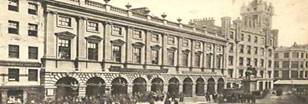
|
Tontine Building |

|
Glasgow Cross is formed from the junction of five streets; namely High Street, Saltmarket, Trongate, London Road (which leads to the famous Barras Market) and Gallowgate.
It is one of the oldest areas of Glasgow and therefore full of history. Although there have been many changes over the years, there are still many remnants of Old Glasgow still to be seen in this area. |
|
There is another Club in Glasgow whose stated interest is concerned with protecting and promoting interest in the architecture and buildings of Glasgow. This is |
|
However, in past years the Old Glasgow Club has also taken an interest in the preservation of Old Glasgow. The Club has met in various noteable locations in the last 100-odd years, including The Athenaeum , the Deaf and Dumb Institute in West Campbell Street, the Trades House in Glassford Street, the Garrick Temperance Hotel in Stockwell Street, the Royal Philosophical Society building in Bath Street, Kelvingrove Museum and the Saracen’s Head Inn. They now meet in Adelaides’, Bath Street. |
|
In 1906, a special meeting of the Club took place in the Court Room of the old Central Police Office in South Albion Street, before it was closed for good in March of that year, and in September 1913, another special meeting took place at 11 High Street, which had been David Dale’s shop and was due for demolition.
The Club also attended the last service in St Enoch’s Church in St Enoch Square before it was demolished. |
|
When the Tolbooth Steeple was threatened with demolition in 1921, the Old Glasgow Club (see more about this Club below), led by then President , Hugh McColl, protested at the suggestion. Thankfully, due to their and other preservationists efforts, the Steeple was saved. |
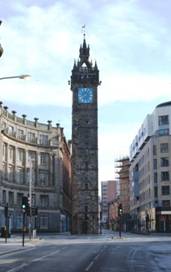
|
The 1921 proposed demolition of the Tolbooth Steeple was not the first time an historical building was threatened, as the Bailie published a poem in 1894, defending the old Tron Steeple. The Tron Church had been burnt down by the Hellfire Club many years before, but the Steeple remained (and remains to this day, now fronting the Tron Theatre). The first two verses are reproduced below. |
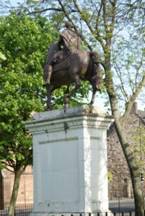
|
By the way, the equestrian statue of King Billy(William of Orange), dressed as a Roman, which once stood in front of the Tontine Building now stands in the High Street, near the Cathedral Precinct.
(See the old postcard photo on the right, showing the Tontine Building, Steeple and the statue), |
|
It is true that the tail of his horse is fitted with a ball-joint and moves ! They say many a drinker gave up the booze after seeing the horse wag its tail !! |
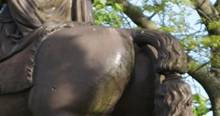
|
What though our brilliant Councillors Are trusted of the people, Another tale will soon be told If they but touch the Steeple
For centuries it staunch has stood, Admired by all the people, Except, of course, the vandals, who Would topple o’er the steeple |

|
In 1934 the Old Glasgow Club presented a plaque, which was affixed to the remaining post of the Old Toll gate on the Parkhouse Toll turnpike road, at Paisley Road. The post has since been moved due to a re-alignment of the roads, but still stands proudly on view at the junction of Govan Road and Paisley Road West. |

|
Here is a close-up of the plaque that was gifted by The Old Glasgow Club. |
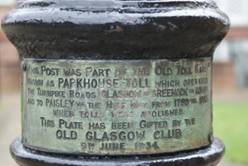
|
I hope you will pay a visit to the Club’s website at
|
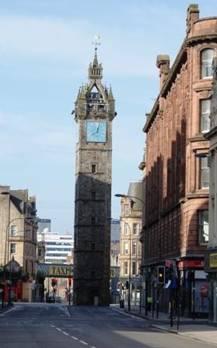

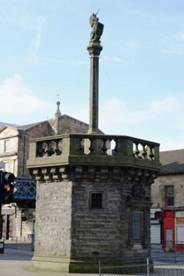

|
The Tolbooth Steeple used to be attached to the Town Hall and the Tontine Building, an hotel which was used by the Tobacco Lords as a place of meetings for business. The steeple now stands in splendid isolation on wee island in the middle of the road, since the building was demolished after a fire in the early 20th century.
Because Bonnie Prince Charlie was talked out of sacking the City when his army was encamped on Glasgow Green, by Cameron of Lochiel, whenever the bearer of that title visits the City, the Steeple Bells ring out in welcome. Otherwise they are heard at the New Year and other special days. |
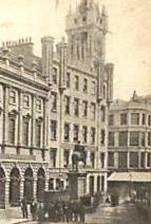
|
The Old Glasgow Club which was mentioned above is an historical Club, which was founded in 1900, after a retired shipbroker named William Liddell wrote to the Evening Citizen and Glasgow Herald to enquire if anyone was interested in forming such a Club. It is still going strong today. I know a bit about it, having been a member for many years.
Its stated aims were to hear papers, reminiscences and notes on Old Glasgow and record them for permanent preservation. To this end, periodically until the 1950s, transactions were published of the talks given to the Club members. A list of these transactions can be viewed on the archive page of the Club’s website.
They also decided to collect books, papers and other memorials of Old Glasgow. Many of these have been given through the years to places such as the People’s Palace, a museum of social history in Glasgow, situated on Glasgow Green. |
|
A brief word about a couple of Clubs dedicated to Glasgow . . . . . . . |


|
The Mercat Cross which now stands at the junction is not the original, which was removed in 1659.
The building there now dates from 1929, when it was gifted to the city by Dr William Black and his wife. There was a dedication service in 1930 attended by the donor (Mrs Black had sadly not lived to see a Cross restored to the City) and civic dignitaries including the Lord Provost, representatives of high office from the Trades House, University, Churches and Government. |
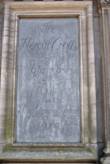
|
The Cross is an octagonal design with a pillar in the centre, on top of which is a unicorn. Prior to the dedication ceremony, a ‘time capsule’ was sealed in to a cavity in the wall which contained documents relating to the gift of the Mercat Cross to the City. |